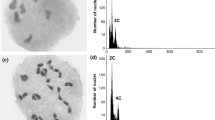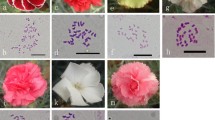Abstract
Diploid families of Tuberosum hybrids as well as Tuberosum-wild species F1 hybrids were generated to select 2n-egg producing genotypes of different genetic backgrounds. Plants were selected if they produced more than four seeds per berry after pollination with tetraploid males (2x⋅ot4x-crosses). From the nine families of Tuberosum hybrids that were derived from one or two 2n-egg producing parents, 12 out of 82 (15%) 2n-egg producing plants were selected. From the 32 families of Tuberosum-wild species F1 hybrids, 21 of 274 (8%) 2n-egg producing plants were selected. The level of 2n-egg formation was estimated in 25 selected diploid hybrids and five control clones (three high, one moderate and one low 2n-egg producers) on the basis of seed set following 2x⋅4x-crosses using 13 tetraploid males in four crossing years. Besides the effect of the diploid 2n-egg producing female on the seed set following 2x⋅4x-crosses (P = 0.0001), there was a significant effect of the tetraploid male (P = 0.0001), whereas the effect of the crossing year (P = 0.0688) was less significant. On the basis of differences in the seed set following 2x⋅4x-crosses as compared to the control clones for low, moderate and high level of 2n-egg formation, the level of 2n-egg formation in two of the newly selected hybrids was classified as very high, four were high, sixteen were moderate and three were low. The significance of the selected hybrids for the genetic analysis of various restitution mechanisms of 2n-egg formation is discussed.
Similar content being viewed by others
References
Barone, A., D. Carputo & L. Frusciante, 1993. Selection of potato diploid hybrids for 2n-egg production. J Genet Breed 47: 131- 318.
Barone, A., C. Gebhardt & L. Frusciante, 1995. Heterozygosity in 2n gametes of potato evaluated by RFLP markers. Theor Appl Genet 91: 98-104.
Bamberg, J.B., C.A. Longtine & E.B. Radcliffe, 1996. Fine screening Solanum (potato) germplasm accessions for resistance to Colorado potato beetle. Amer Potato J 73: 211-223.
Bastiaanssen, H.J.M., M.S. Ramanna, Z. Sawor, A. Mincione, A. v.d. Steen & E. Jacobsen, 1996. Pollen genetic markers for genecentromere mapping in diploid potato. Theor Appl Genet 93: 1040-1047.
Brown, C.R. & P.E. Thomas, 1994. Resistance to potato leafroll virus derived from Solanum chacoense: characterization and inheritance. Euphytica 74: 51-57.
Chase, S.S., 1963. Analytic breeding in Solanum tuberosumL. - a scheme to utilize parthenotes and other diploid stocks. Can J Genet Cytol 5: 359-363.
Conicella, C., A. Barone, A. Del Giudice, L. Frusciante & L.M. Monti, 1991. Cytological evidence of SDR-FDR mixture in the formation of 2n eggs in a potato diploid clone. Theor Appl Genet 81: 59-63.
Douches, D.S. & C.F. Quiros, 1988. Genetic strategies to determine the mode of 2n egg formation in diploid potatoes. Euphytica 38: 247-260.
Gebhardt, C., E. Ritter, A. Barone, T. Debener, B. Walkemeier, U. Schachtschabel & H. Kaufmann, 1991. RFLP maps of potato and their alignment with the homoeologous tomato genome. Theor Appl Genet 83: 49-57.
Hanneman, R.E. & S.J. Peloquin, 1968. Ploidy levels of progeny from diploid-tetraploid crosses in the potato. Am Potato J 45: 255-261.
Hermsen, J.G. Th., 1984. Mechanisms and genetic implications of 2n-gamete formation. Iowa State J Res 58: 421-434.
Hutten, R.C.B., M.G.M. Schippers, J.G.Th. Hermsen & M.S. Ramanna, 1994. Comparative performance of FDR and SDR progenies from reciprocal 4x2x crosses in potato. Theor Appl Genet 89: 545-550.
Iwanaga, M. & S.J. Peloquin, 1982. Origin and evolution of cultivated tetraploid potatoes via 2n gametes. Theor Appl Genet 61: 161-169.
Jacobs, J.M.E., H.J. v. Eck, P. Arens, B. VerkerkBakker, B. te Lintel Hekkert, H.J.M. Bastiaanssen, A. ElKharbotly, A. Pereira, E. Jacobsen & W.J. Stiekema, 1995. A genetic map of potato (Solanum tuberosum) integrating molecular markers, including transposons, and classical markers. Theor Appl Genet 91: 289- 300.
Jacobsen, E., 1976. Cytological studies of diplandroid production in a dihaploid potato clone and its correlation with seed set in 4x2x crosses. Z Pflanzenzücht 77: 10-15.
Jacobsen, E., J.H.M. Hovenkamp-Hermelink, H.T. Krijgsheld, H. Nijdam, L.P. Pijnacker, B. Witholt & W.J. Feenstra, 1989. Phenotypic and genotypic characterization of an amylosefree starch mutant of the potato. Euphytica 44: 43-48.
Janssen, G.J.W., A. Van Norel, B. Verkerk-Bakker & R. Janssen, 1997. Resistance to Meloidogyne chitwoodi, M. fallax, and M. haplain wild tuberbearing Solanumspp. Euphytica 92: 287- 294.
Jongedijk, E., 1985. The pattern of megasporogenesis and megagametogenesis in diploid Solanumspecies hybrids; its relevance to the origin of 2n-eggs and the induction of apomixis. Euphytica 34: 599-611.
Jongedijk, E., R.C.B. Hutten, J.M.A.S.A. van der Wolk & S.I.J. Schuurmans-Stekhoven, 1991a. Synaptic mutants in potato, Solanum tuberosumL. III. Effect of the Ds-1/ ds-1 locus (desynapsis) on genetic recombination in the male and female meiosis. Genome 34: 121-130.
Jongedijk, E., M.S. Ramanna, Z. Sawor & J.G. Th. Hermsen, 1991b. Formation of first division restitution FDR 2n-megaspores through pseudohomotypic division in ds1 desynapsis mutants of diploid potato: Routine production of tetraploid progeny from 2x FDR-2x FRD crosses. Theor Appl Genet 82: 645-656.
Marks, G.E., 1966. The origin and significance of intraspecific polyploidy: experimental evidence from Solanum chacoense. Evolution 20: 552-557.
Mendiburu, A.O. & S.J. Peloquin, 1977. Bilateral sexual polyploidization in potatoes. Euphytica 26: 573-583.
Mendiburu, A.O. & S.J. Peloquin, 1979. Genecentromere mapping by 4x-2x matings in potato. Theor Appl Genet 54: 177-180.
Mok, D.W.S. & S.J. Peloquin, 1975. Three mechanisms of 2npollen formation in diploid potatoes. Can J Genet Cytol 17: 217-225.
Nijs, T.P.M. den & S.J. Peloquin, 1977. 2n gametes in potato species and their function in sexual polyploidization. Euphytica 26: 585- 600.
Ortiz, R., S.J. Peloquin, R. Freyre & M. Iwanaga, 1991. Efficiency of potato breeding using FDR 2n gametes for multitrait selection and progeny testing. Theor Appl Genet 82: 602-608.
Ortiz, R. & S.J. Peloquin, 1992. Recurrent selection for 2n gametes production in 2x potatoes. J Genet Breed 46: 383-390.
Qu, D.Y., Zhu Dewei, M.S. Ramanna & E. Jacobsen, 1996. A comparison of progeny from diallel crosses of diploid potato with regard to the frequencies of 2npollen grains. Euphytica 92: 313-320.
Peloquin, S.J., 1983. Genetic engineering with meiotic mutants. In: D.L. Mulcany & E. Ottaviano (Eds), Pollen: Biology and Implications for Plant Breeding, pp. 311-316. Elsevier, New York.
Ramanna, M.S., 1979. A reexamination of the mechanisms of 2n gamete formation in potato and its implications for breeding. Euphytica 28: 537-561.
Ramanna, M.S., 1983. First division restitution gametes through fertile desynaptic mutants of potato. Euphytica 32: 337-350.
SAS Institute Inc., 1989. SAS/STAT User's Guide, version 6, Fourth edition, Volume 2, pp. 891-1686. SAS Institute Inc., Cary, NC.
Stelly, D.M. & S.J. Peloquin, 1986a. Diploid female gametophyte formation in 24chromosome potatoes: genetic evidence for the prevalence of the second meiotic division restitution mode. Can J Genet Cytol 28: 101-108.
Stelly, D.M. & S.J. Peloquin, 1986b. Formation of 2n megagametophytes in diploid tuberbearing Solanums. Amer J Bot 73 (9): 1351-1363.
Veilleux, R., 1985. Diploid and polyploid gametes in crop plants: Mechanisms of formation and utilization in plant breeding. Plant Breed Rev 3: 252-288.
Watanabe, K. & S.J. Peloquin, 1989. Occurrence of 2n pollen and psgene frequencies in cultivated groups and their related wild species in tuber-bearing Solanums. Theor Appl Genet 78: 329- 336.
Watanabe, K. & S.J. Peloquin, 1993. Cytological basis of 2n pollen formation in a wide range of 2x, 4x, and 6x taxa from tuberbearing Solanumspecies. Genome 36: 8-13.
Werner, J.E. & S.J. Peloquin, 1987. Frequency and mechanisms of 2n egg formation in haploid Tuberosumwild species F1 hybrids. Am Potato J 65: 641-654.
Werner, J.E. & S.J. Peloquin, 1991. Occurrence and mechanisms of 2n egg formation in 2x potato. Genome 23: 975-982.
Werner, J.E., D.S. Douches & R. Freyre, 1992. Use of half-tetrad analysis to discriminate between two types of 2n egg formation in a potato haploid.
Author information
Authors and Affiliations
Rights and permissions
About this article
Cite this article
Bastiaanssen, H.J., Ramanna, M., Huigen, DJ. et al. Selection of diploid tuberous Solanum hybrids for 2n-egg formation using 2x⋅4x-crosses. Euphytica 101, 325–339 (1998). https://doi.org/10.1023/A:1018391013013
Issue Date:
DOI: https://doi.org/10.1023/A:1018391013013




